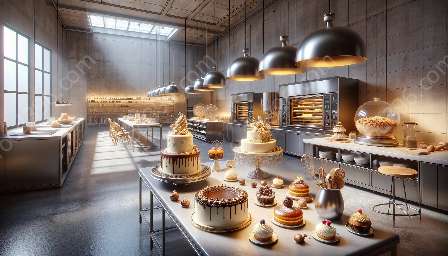Gluten-free baking has become a popular trend among health-conscious individuals and those with gluten intolerances. This comprehensive guide explores gluten-free baking in the context of cake and pastry production and baking science & technology, covering tips, methods, and recipes for creating delicious gluten-free pastries and cakes.
Understanding Gluten-Free Baking
Gluten is a protein found in wheat, barley, and rye that provides elasticity and structure in baked goods. However, for individuals with gluten sensitivities or celiac disease, consuming gluten can lead to adverse health effects. As a result, the demand for gluten-free baked goods has surged, prompting bakers to explore alternative ingredients and techniques to create equally delectable treats without gluten.
Gluten-free baking presents a unique set of challenges, as the absence of gluten can affect the texture, rise, and flavor of baked goods. However, with the right knowledge and approach, it is possible to produce gluten-free cakes and pastries that are on par with their gluten-containing counterparts.
Adapting to Gluten-Free Baking
When transitioning to gluten-free baking, it's essential to understand the characteristics of alternative flours and binders commonly used in gluten-free recipes. Almond flour, coconut flour, rice flour, and tapioca flour are popular gluten-free alternatives that offer distinct textures and flavors. Additionally, xanthan gum and psyllium husk are often used as binding agents to mimic the structure provided by gluten.
Moreover, the use of leavening agents such as baking powder and yeast plays a crucial role in achieving the desired rise and crumb in gluten-free baked goods. Understanding the science behind these leavening agents and their interaction with gluten substitutes is fundamental to successful gluten-free baking.
Baking Science & Technology in Gluten-Free Recipes
Baking science and technology provide valuable insights into the chemical and physical processes involved in gluten-free baking. From the hydration and protein content of alternative flours to the impact of different sugar types on browning and caramelization, understanding these principles can enhance the quality and taste of gluten-free cakes and pastries.
Tips for Gluten-Free Cake and Pastry Production
- Use high-quality gluten-free ingredients to ensure the best results. Invest in reputable brands of alternative flours, binders, and leavening agents for consistent performance.
- Experiment with a variety of gluten-free flours to create unique flavor profiles and textures. Blend different flours in recipes to achieve optimal results.
- Adjust the hydration levels and fat content in gluten-free batters and doughs to maintain moisture and prevent dryness, which can be common in gluten-free products.
- Employ advanced techniques such as pre-gelatinization of starches and incorporation of emulsifiers to enhance the structure and shelf life of gluten-free cakes and pastries.
Delicious Gluten-Free Recipes
Explore these mouthwatering gluten-free recipes to elevate your baking skills:
Gluten-Free Chocolate Cake
- Ingredients:
- 1 cup almond flour
- 1/2 cup cocoa powder
- 1/2 cup sugar
- 2 eggs
- 1/4 cup coconut oil
- 1 tsp baking powder
- 1 tsp vanilla extract
- 1/2 cup dairy-free milk
- Instructions:
- Preheat the oven to 350°F. Grease and line a cake pan with parchment paper. In a bowl, whisk together almond flour, cocoa powder, and baking powder. In another bowl, beat the eggs, sugar, coconut oil, and vanilla extract. Gradually mix in the dry ingredients, alternating with the dairy-free milk. Pour the batter into the prepared pan and bake for 25-30 minutes. Allow the cake to cool before serving.
Gluten-Free Blueberry Muffins
- Ingredients:
- 1 1/2 cups gluten-free flour blend
- 1/2 cup sugar
- 2 tsp baking powder
- 1/2 tsp salt
- 1/2 cup dairy-free milk
- 1/4 cup coconut oil
- 1 egg
- 1 cup fresh blueberries
- Instructions:
- Preheat the oven to 375°F. Line a muffin tin with paper liners. In a bowl, combine the gluten-free flour, sugar, baking powder, and salt. In a separate bowl, whisk together the dairy-free milk, coconut oil, and egg. Gradually add the wet ingredients to the dry ingredients, then gently fold in the blueberries. Divide the batter among the muffin cups and bake for 20-25 minutes. Allow the muffins to cool before serving.
Conclusion
Gluten-free baking offers a world of possibilities for creating delectable cakes and pastries that cater to a diverse range of dietary needs. By understanding the principles of gluten-free baking, leveraging baking science and technology, and experimenting with innovative recipes, bakers can delight their customers and patrons with irresistible gluten-free treats that rival traditional counterparts.

